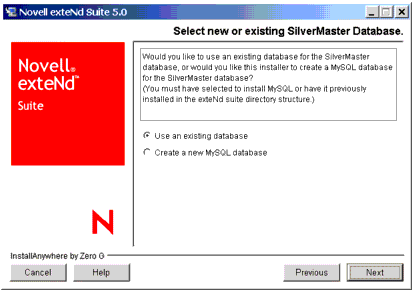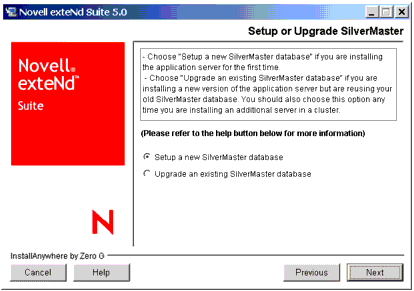
Installing Novell exteNd
CHAPTER 5
This chapter presents an overview of the Custom installation type. Topics include:
The Custom option allows you to select which features are installed on your machine. You can specify your own preferences for databases, port numbers, and passwords. Custom is available on all platforms.
When you run the Custom install, the questions presented vary depending on selections you make along the way, as well as which install key you are using. The following comprises an aggregation of all options as seen using an exteNd Enterprise Suite license on Windows.
 To run the Novell exteNd product suite installation program—using the Custom option:
To run the Novell exteNd product suite installation program—using the Custom option:
You must exit all Windows programs before running the installation program Read the introduction screen and click Next.
To install the suite, you must accept the license agreement. Click Next.
Your installation key determines what functionality gets installed.
Choose your installation type and click Next.
TIP: This chapter focuses on the Custom install option. For other options, see the appropriate chapters in this book.
The following screen allows you to select the items that you choose to install.
The options in the Install Set list are determined by the installation key you entered. You can click an item in the list to display a description in the Description box.
After selecting all the items you want to install, click Next.
Enter the path to where you would like to install the suite. The default is C:\Program Files\Novell\exteNd5.
Click Next. If the directory does not exist, you are asked if you would like to have it created. Click Next.
If you chose to install MySQL, enter the MySQL Listener port number. The default port number is 63306. Click Next.
TIP: For information regarding the use of MySQL as SilverMaster, review the Release Notes.
Enter the database password used for the MySQL database root user. Click Next.
Specify what you will use for a SilverMaster database.  .
.
|
Option |
Description |
|---|---|
|
Use an existing database |
Select this option if you have created your own database to be used as SilverMaster |
|
Create a new MySQL database |
Select this option if you would like to have the installer create a new MySQL database to use as SilverMaster. If you select this option, skip to Step 11. |
If you chose to use a database that you have already created, the install prompts you for more information about the database:
 For more information about the SilverMaster database and setting it up, see the exteNd Application Server Administrator's Guide (especially the chapter on data source configuration).
For more information about the SilverMaster database and setting it up, see the exteNd Application Server Administrator's Guide (especially the chapter on data source configuration).
Select whether you want to set up a new SilverMaster or upgrade an existing one.

Enter the driver settings for your SilverMaster database. Click Next.
Enter the database name, user name, and password for the SilverMaster database. Click Next.
Specify the HTTP port number the server will listen on. The default value is 80. Click Next.
 For more information, see the chapter on running the server in the exteNd Application Server Administrator's Guide.
For more information, see the chapter on running the server in the exteNd Application Server Administrator's Guide.
If you are installing the Application Server, you are asked to specify whether you want to restrict access to the server. When access is restricted, unauthorized users will not be able to access administration operations or browse directory listings.
 For more information, see the chapter on using security in the exteNd Application Server Administrator's Guide.
For more information, see the chapter on using security in the exteNd Application Server Administrator's Guide.
If you are creating or upgrading a SilverMaster database, you are prompted to define the administration account (user name and password) for the server.
The installation program creates a user with this name and password and assigns the user Locksmith privileges. Your server's administrator will log in to the server using this account.
 For more information, see the chapter on setting up users and groups in the exteNd Application Server Administrator's Guide.
For more information, see the chapter on setting up users and groups in the exteNd Application Server Administrator's Guide.
Choose whether you want to run the Application Server as a service.
 For more information on running as a service, see Installing the Application Server as a Service or Daemon.
For more information on running as a service, see Installing the Application Server as a Service or Daemon.
Enter a Cache Coordinator RMI Port number. This port is used by exteNd Director for communicating with different instances of your exteNd Director application in a clustered server environment. The default port number is 54490.
A preinstallation summary screen displays. If everything is correct, click Install to proceed with the installation.
Copyright © 2004 Novell, Inc. All rights reserved. Copyright © 1997, 1998, 1999, 2000, 2001, 2002, 2003 SilverStream Software, LLC. All rights reserved. more ...